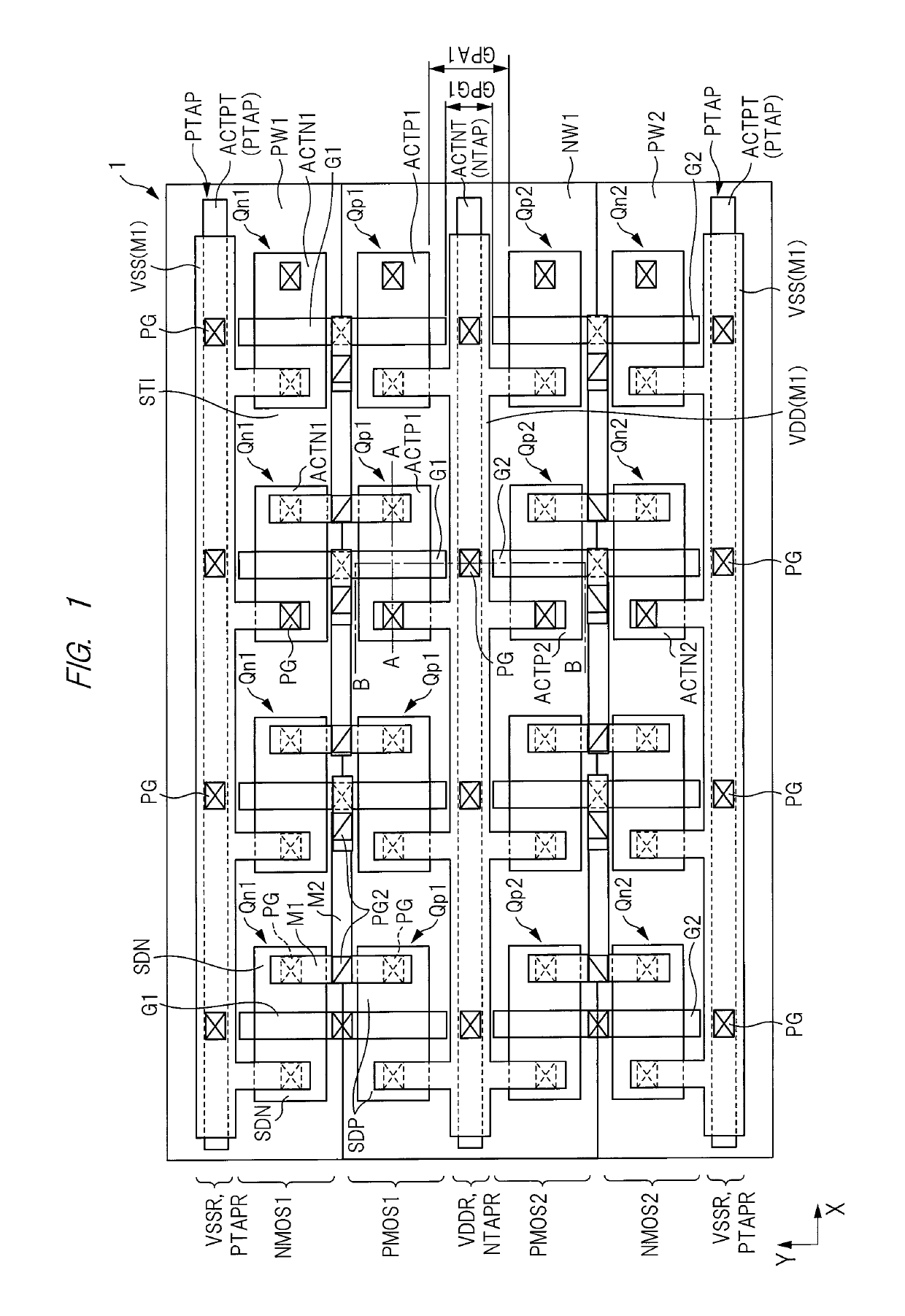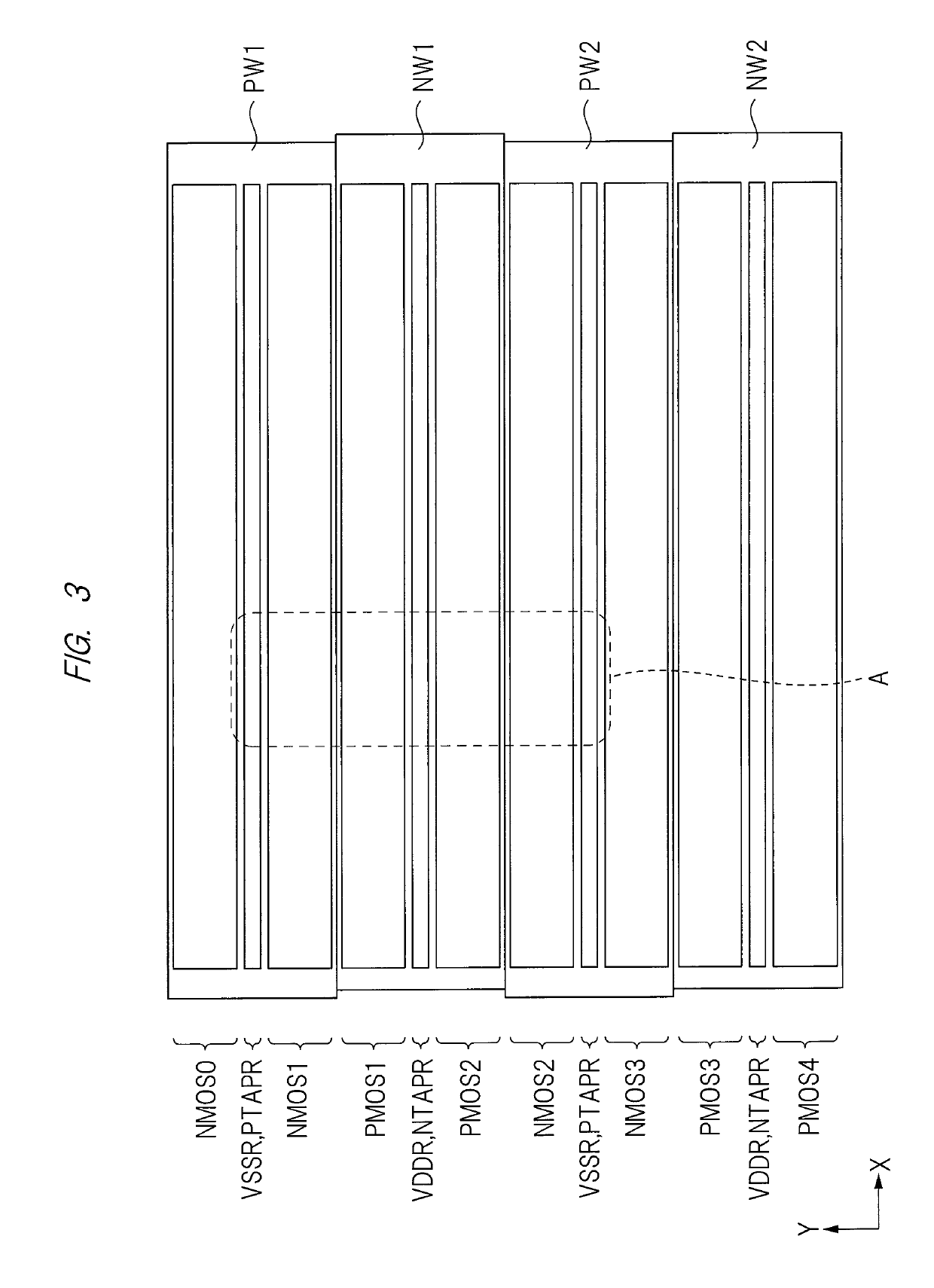Semiconductor device
a technology of semiconductor devices and semiconductors, applied in the field of semiconductor devices, can solve the problems of weakened (or deteriorated) implants at high energy, the reliability of semiconductor devices according to the related art is low, and the insulating film zmb>2/b> is more difficult to be polished than the insulating film, so as to achieve the effect of improving the reliability of semiconductor devices
- Summary
- Abstract
- Description
- Claims
- Application Information
AI Technical Summary
Benefits of technology
Problems solved by technology
Method used
Image
Examples
first embodiment
Main Features of Present First Embodiment
[0117]In the n-type tap region NTAPR, the epitaxial layer EP is not formed on the main surface of the n-type well region NW1 (i.e., the semiconductor substrate SB). More specifically, the embodiment has such a feature that the lower surface of the silicide layer SL in the active region ACTNT of the n-type tap region NTAPR is lower by d1 than the lower surface of the insulating layer BX in the active region ACTP1 which is the formation region of the p-type MISFET Qp1 (closer to the back surface of the semiconductor substrate SB). This feature can prevent the short circuit or the breakdown voltage deterioration between the n-type well region NW1 and the gate electrodes G1 or G2 of the p-type MISFET Qp1 close to the n-type tap region NTAPR.
[0118]In the p-type tap region PTAPR, the epitaxial layer EP is formed on the main surface of the p-type well region PW1 (i.e., the semiconductor substrate SB). More specifically, the embodiment has such a fea...
second embodiment
[0119]The present second embodiment is a modification example of the first embodiment, and only differences from the first embodiment will be explained. FIG. 19 is a plan view of a semiconductor device according to the present second embodiment. FIG. 20 is a detailed plan view of the part B of FIG. 19. FIG. 21 is a cross-sectional view taken along a line G-G, a line H-H, a line I-I, a line J-J, a line K-K, and a line L-L of FIG. 20. In FIG. 21, a cross-sectional view along the line G-G of FIG. 20 is shown in a region GG, a cross-sectional view along the line H-H of FIG. 20 is shown in a region HH, a cross-sectional view along the line I-I of FIG. 20 is shown in a region II, a cross-sectional view along the line J-J of FIG. 20 is shown in a region JJ, a cross-sectional view along the line K-K of FIG. 20 is shown in a region KK, and a cross-sectional view along the line L-L of FIG. 20 is shown in a region LL. FIG. is a cross-sectional view in a step of manufacturing the semiconductor ...
third embodiment
[0140]FIG. 23 is a plan view of a semiconductor device according to the present third embodiment.
[0141]As shown in FIG. 23, the semiconductor device according to the present third embodiment uses the structure of the first embodiment for the NMOS regions NMOS0 to NMOS3 and the p-type tap region PTAPR in the p-type wells PW1 and PW2, and uses the structure of the second embodiment for the PMOS regions PMOS1 to PMOS4 and the n-type tap region NTAPR1 in the n-type well regions NW1 and NW2. More specifically, the structure of the second embodiment can be employed only for a portion that is largely affected by the dent DT of the element isolation region STI. As a result, the flexibility of the layout design can be increased.
PUM
 Login to View More
Login to View More Abstract
Description
Claims
Application Information
 Login to View More
Login to View More - R&D
- Intellectual Property
- Life Sciences
- Materials
- Tech Scout
- Unparalleled Data Quality
- Higher Quality Content
- 60% Fewer Hallucinations
Browse by: Latest US Patents, China's latest patents, Technical Efficacy Thesaurus, Application Domain, Technology Topic, Popular Technical Reports.
© 2025 PatSnap. All rights reserved.Legal|Privacy policy|Modern Slavery Act Transparency Statement|Sitemap|About US| Contact US: help@patsnap.com



